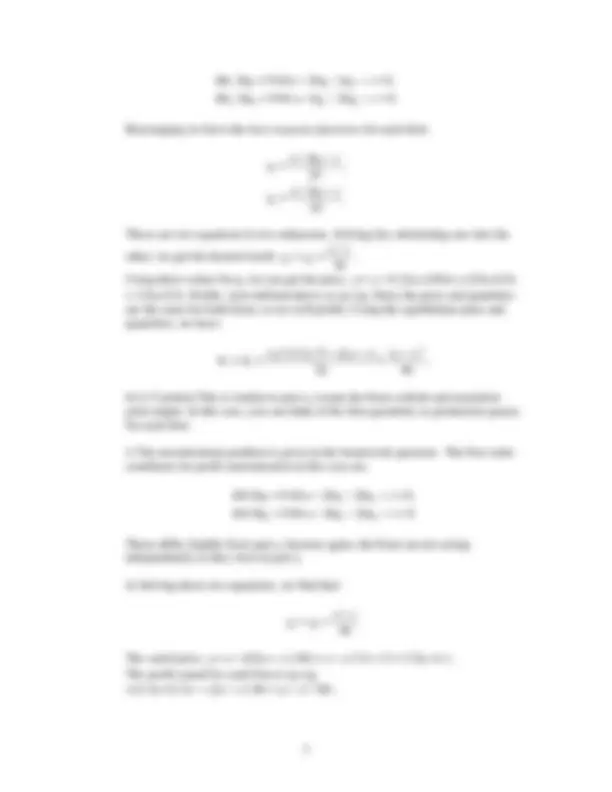




Study with the several resources on Docsity

Earn points by helping other students or get them with a premium plan


Prepare for your exams
Study with the several resources on Docsity

Earn points to download
Earn points by helping other students or get them with a premium plan
Community
Ask the community for help and clear up your study doubts
Discover the best universities in your country according to Docsity users
Free resources
Download our free guides on studying techniques, anxiety management strategies, and thesis advice from Docsity tutors
Material Type: Assignment; Class: GAME THEORY; Subject: Economics; University: University of Pittsburgh; Term: Fall 2008;
Typology: Assignments
1 / 4

This page cannot be seen from the preview
Don't miss anything!



Economics 1200 Fall 2008
b) [1 point] In the infinitely repeated game, we showed in class that if Player 1 (the buyer) moves first, he will propose to keep [(1-d)/(1-d^2 )]M for himself with the remainder going to Player 2 (the seller). This proposal will be made in the first round and is acceptable to Player 2. With δ=.2 player 1 (the buyer) will propose to keep [(1-.2)/(1-(.2) 2 )] 12,000 = (5/6)(12,000) = $10,000 for himself with the remainder, $2,000 going to player 2 (the seller). So the equilibrium sale price in this case is $190,000 ($188,000+$2,000). Player 1 would prefer an infinite number of rounds to just a single round since he gets to keep slightly more of M ($400 more) for himself if he is the first mover.
b) [1 point] In stag hunt, there are two pure strategy Nash equilibria which you can find by best response analysis. These are: Cooperate, Cooperate with a payoff of 70,70 and Defect, Defect with a payoff of 40, 40.
c) [1 point] In chicken, there are two pure strategy Nash equilibria which you can find by best response analysis. These are: Cooperate, Defect with a payoff of 50,80 and Defect, Cooperate with a payoff of 80, 50.
Sam’s Choice Ball Game Concert Pat’s Ball Game 4,3 3, Choice Concert 1,1 2,
b) [1/2 point] The unique Nash equilibrium for this game, found via best response analysis, is for both players to choose the Ball Game. Pat’s dominant strategy is to choose Ball Game, while Sam does not have a dominant strategy. But Sam, understanding Pat’s strong preference for the game, will know to go to the ball game rather than the concert, even without being able to communicate with Pat.
Jack’s Choice
The Nash equilibria in pure strategies are all choices that result in an outcome along the diagonal (6 total): (G,G), (K,K), (L,L), (Q,Q), (R,R), (W,W). These can be found using best response analysis.
b) [1/2 point] Focal is a subjective concept as we have observed in class; any of the six equilibria could be focal depending on the underlying common cultural understandings of the two players, though to achieve a focal equilibrium, their expectations would have to converge. One possible candidate is (Q,Q), because it is the only equilibrium that yields both players the same payoff (3), (equity considerations, envy-freeness). Another candidate might be (L,L), as it yields the highest total sum of payoffs (10) (efficiency). Yet another might be (G,G), e.g. in a society that emphasized the importance of being first, etc.
2 2 1 2 2
1 1 1 2 1 p cq a bq q c q
p cq a bq q cq = − = − + −
Profit maximization by each firm involves taking the derivative of the profit function with respect to the quantity supplied by the firm and setting this derivative equal to zero to find the optimal, profit maximizing price. That is, we set
iii) Notice that the cartel quantity is lower than in the duopoly case, prices are higher as are firm profits. The reason is simple: collusion by the two firms allows them to act as a monopolist, and therefore they can restrict quantity and enjoy monopoly pricing and profits.